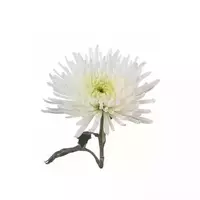Chrysanthemum flowers

Since ancient times, chrysanthemum flowers have been known not only as an excellent ornamental plant - among a considerable number of various varieties and species of chrysanthemums, a unique edible is also distinguished, which uses not only inflorescences, but also young shoots with leaflets.
It has been proven that due to the special properties of chrysanthemum, eating it can contribute to the prolongation of life. In addition, chrysanthemum flowers are indispensable in medical and dietary nutrition. Edible chrysanthemum is especially useful when fresh. Chrysanthemum flowers and young leaves of the plant are distinguished by a specific pleasant smell, delicate aroma and savory taste.
Young chrysanthemum leaves, colored dark green, are used in salads. In addition, they are often stewed with vegetables, boiled or eaten raw. Fresh or boiled buds, as well as blossomed chrysanthemum flowers, are an exquisite decoration of various dishes. From chrysanthemum flowers, soups are even boiled and salted for future use.
Edible chrysanthemum species are especially popular in East Asia and Japan, and in recent years in Europe and America. An annual plant has appeared in Russia, where it is grown both in protected and open ground.
It is noteworthy that chrysanthemum flowers have been cultivated in China for more than thirty centuries, and they are grown not only for the purpose of aesthetic delight, but also for medicine and cooking - for example, a salad of chrysanthemum petals is still served as seasoning in China.
And Chinese chefs know how to make an incredibly delicious dessert of chrysanthemum flowers, which resembles a very delicate cake. For this, chrysanthemum petals are dipped in a mixture of flour and eggs, taken out, quickly dipped in melted oil, laid out on paper (so the excess oil is better absorbed), and then sprinkled with sugar. Serve such a treat with ice cream. By the way, in elite restaurants in China, this exquisite dessert of chrysanthemum flowers has become so fashionable that connoisseurs and foodies deliberately come there to feast only on this dish.
Chrysanthemum species
According to some reports, the genus of this plant has up to 29 species of chrysanthemum, which grow in the northern and temperate zones of the globe (for the most part in Asia). Regarding the edible species of chrysanthemum, it can be said that it is called chrysanthemum crowned (vegetable or salad), and its homeland is North America.
Chrysanthemum composition
The composition of chrysanthemum is distinguished by the presence of a considerable amount of vitamins and trace elements, which are vital for the health of human skin, nails and hair. So, this beautiful flower contains phosphorus, silicon, potassium, magnesium, selenium, zinc. And the chrysanthemum petals are rich in thiamine, essential oils, adenine, niacin, riboflavin, ascorbic acid and carotene.
chrysanthemum flowers 24 kCal
The energy value of chrysanthemum flowers (Ratio of proteins, fats, carbohydrates - ju):
Proteins: 3.36 g (~ 13 kCal)
Fats: 0.56 g. (~ 5 kCal)
Carbohydrates: 0.02 g (~ 0 kCal)
Energy ratio (b | y): 56% | 21% | 0%
 Español
Español Français
Français Português
Português Русский
Русский 简体中文
简体中文 繁體中文
繁體中文 日本語
日本語 한국어
한국어 العربية
العربية Türkçe
Türkçe Қазақ
Қазақ Deutsch
Deutsch Italiano
Italiano Українська
Українська
